Salesforce CPQ + Conversational AI: Demo and Use Cases
TL;DR:
Learn how conversational AI changes Salesforce CPQ from a multi-step clicking process into natural language interactions. See live demos of creating quotes, configuring complex bundles, and accessing CPQ through voice commands - all while respecting your existing business rules and security requirements. Implementation takes 3-6 weeks with no Data Cloud dependency.
Not a fan of reading? Watch the Salesforce CPQ + AI here:
.What? A practical demonstration of using conversational AI to automate complex quoting processes in Salesforce CPQ, from simple product additions to configuring sophisticated bundles through natural language interactions.
Who? Salesforce CPQ users, sales operations teams, deal desk professionals, CPQ administrators, and revenue operations leaders looking to reduce friction in the quoting process while maintaining guardrails and business rules.
Why? CPQ interfaces often require too many clicks and manual overhead, creating adoption challenges and slowing down deal velocity. AI enables natural language interactions that respect existing business rules while dramatically simplifying the user experience.
Key Benefit: Change quote creation from a multi-step process into a conversation. Reduce time-to-quote while maintaining compliance.
What can you do with it?
- Create and configure quotes through conversation instead of clicking through multiple CPQ screens
- Access CPQ from anywhere - chatbot, voice calls, Teams, Slack, or WhatsApp
- Automate routine quoting tasks while maintaining all your existing business rules and approvals
The CPQ User Experience Challenge
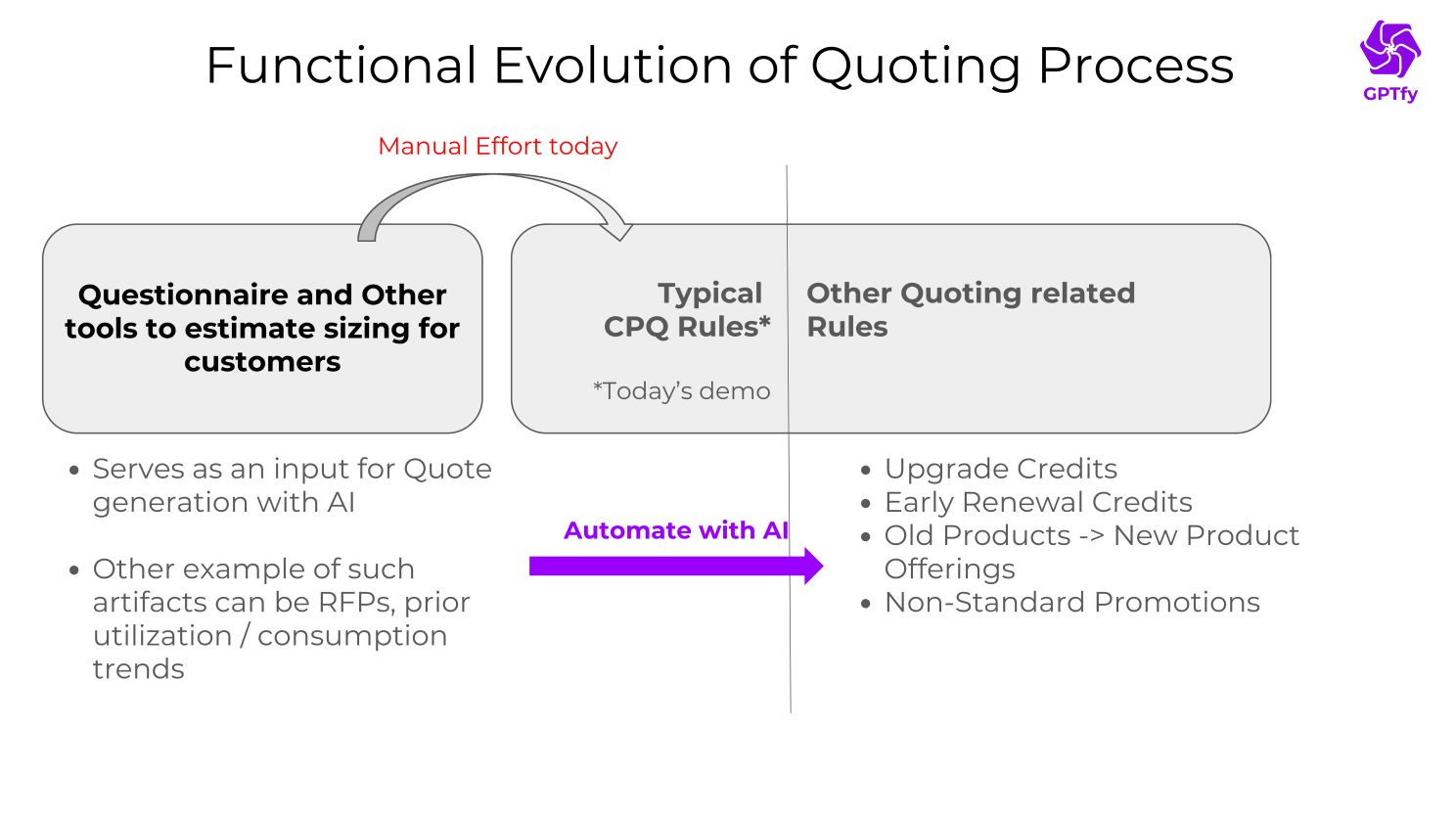
Salesforce CPQ sits at an interesting crossroads. While Revenue Cloud Advanced (RCA) offers compelling new architecture with its API-first, agent-ready design, most organizations aren't moving immediately. They have significant CPQ investments and aren't ready for a platform migration.
Yet these teams face real pain points that AI can address today:
Too Many Clicks, Too Much Complexity
The CPQ interface works, but getting through quote creation and bundle configuration requires navigating multiple screens, understanding product dependencies, and remembering business rules. For sales reps trying to close deals, this friction creates bottlenecks.
Hidden Costs of Supporting CPQ Users
Deal desk and sales operations teams spend significant time helping reps navigate CPQ complexity. Excel spreadsheets proliferate despite the CPQ investment because users find them easier for certain tasks. This support overhead compounds as organizations scale.
Launch Delays for New Offerings
Introducing new products or bundles typically requires months of CPQ configuration work. This planning requirement can limit business agility when market conditions demand quick responses.
Here's the reality check: CPQ wasn't designed for conversational interfaces. The platform requires structured inputs through specific UI elements. AI doesn't change CPQ's underlying architecture, but it creates a translation layer between natural language and the structured actions CPQ requires.
How AI Changes the Interaction Model
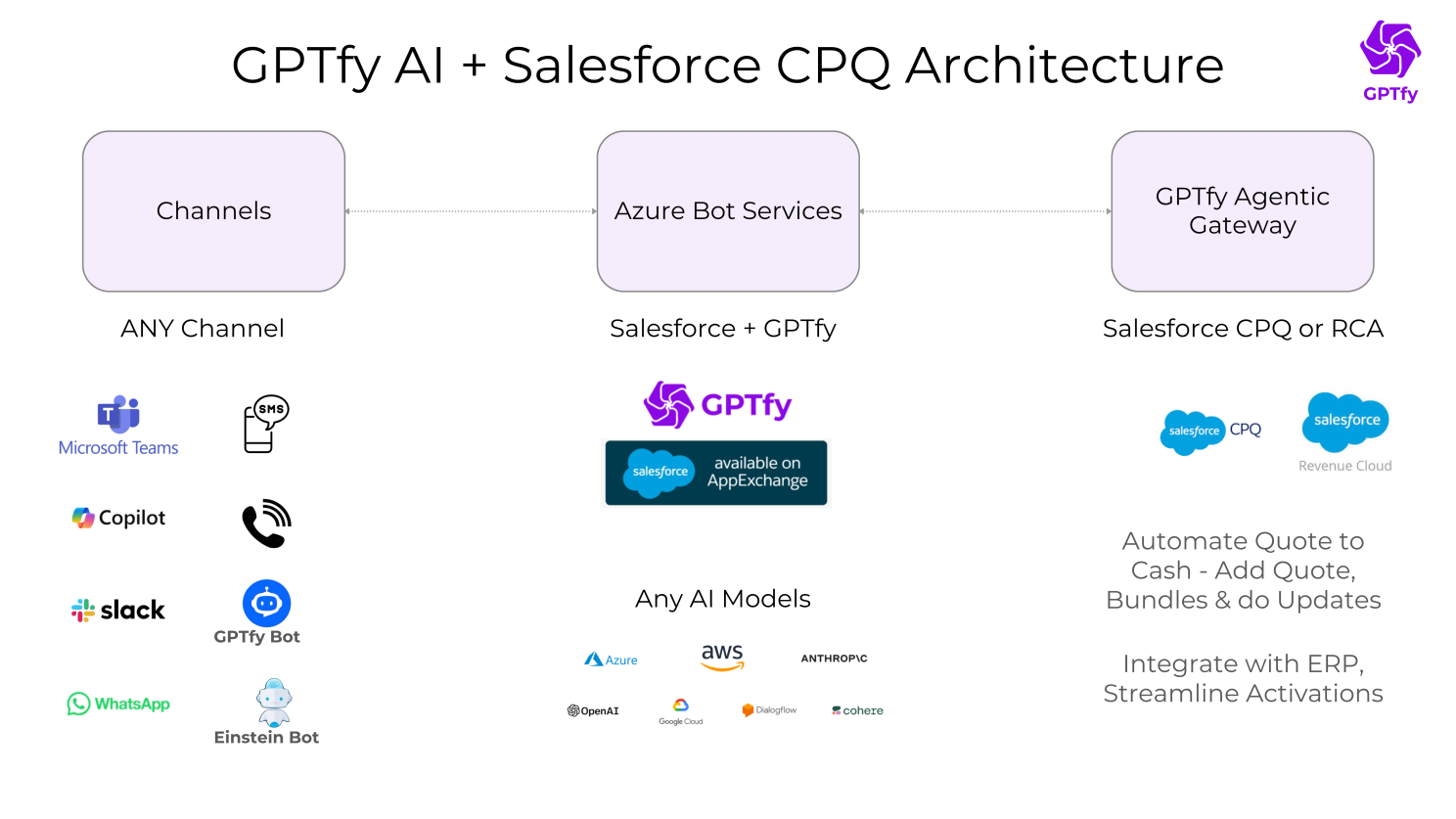
User Request → AI Intent Recognition → Business Rule Validation → CPQ API Call → Result
Rather than clicking through CPQ screens, users describe what they need. The AI handles the translation work - understanding intent, validating against business rules, and executing the appropriate CPQ actions.
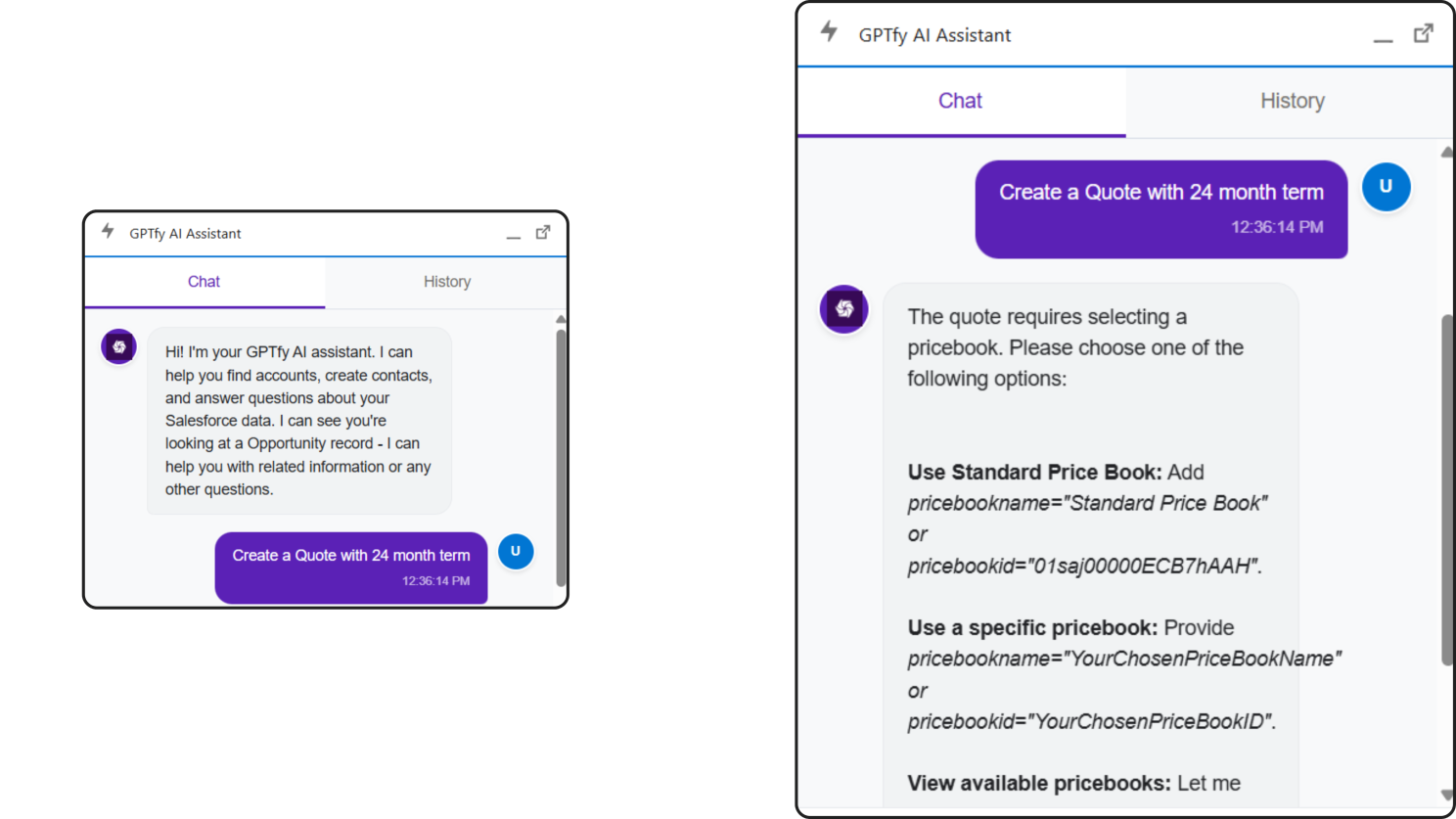
Creating Quotes
Sales reps need to initiate quotes quickly without navigating through multiple setup screens. A user types: "Create a quote with 24 month term." The AI recognizes this requires a price book selection (a mandatory CPQ business rule) and prompts for that information before proceeding. When provided, it creates the quote and navigates the user directly to it.
Adding Simple Products
Adding standard products to quotes is a frequent task. Users can simply say: "Add AWS Cloud Services to this quote." The AI validates the product exists in the price book and adds it to the quote line items.
Specifying Quantities and Discounts
Rather than adding products and then adjusting quantities and discounts through separate steps, users can specify everything at once. For example: "Add 15 AWS instances to this quote with a 10% discount." The AI parses the intent, validates the product exists, applies the quantity and discount (while respecting approval thresholds), and adds it to the quote.
Handling Multiple Operations in One Request
Sales teams often need to create multiple similar quotes for different time periods or scenarios. Instead of repeating the same process multiple times, they can request everything at once. A user says: "Create three quotes for Q1, Q2, and Q3 renewals, each with 24-month terms." The AI executes all three operations sequentially while maintaining proper validation for each.
Error Handling and Clarification
When users make mistakes or forget required information, the AI provides helpful guidance. Attempting to add a misspelled product name results in: "I cannot find that product." If a user forgets required information, the AI prompts: "Which price book should I use for this quote?" This conversational error handling reduces frustration compared to cryptic error messages in traditional interfaces.
Key Insight: This isn't magic - it's intelligent parsing combined with CPQ API integration. The AI understands CPQ's requirements and enforces them through conversation rather than form fields.
The Bundle Configuration Problem
Simple product additions work predictably in CPQ. Complex bundles create headaches.
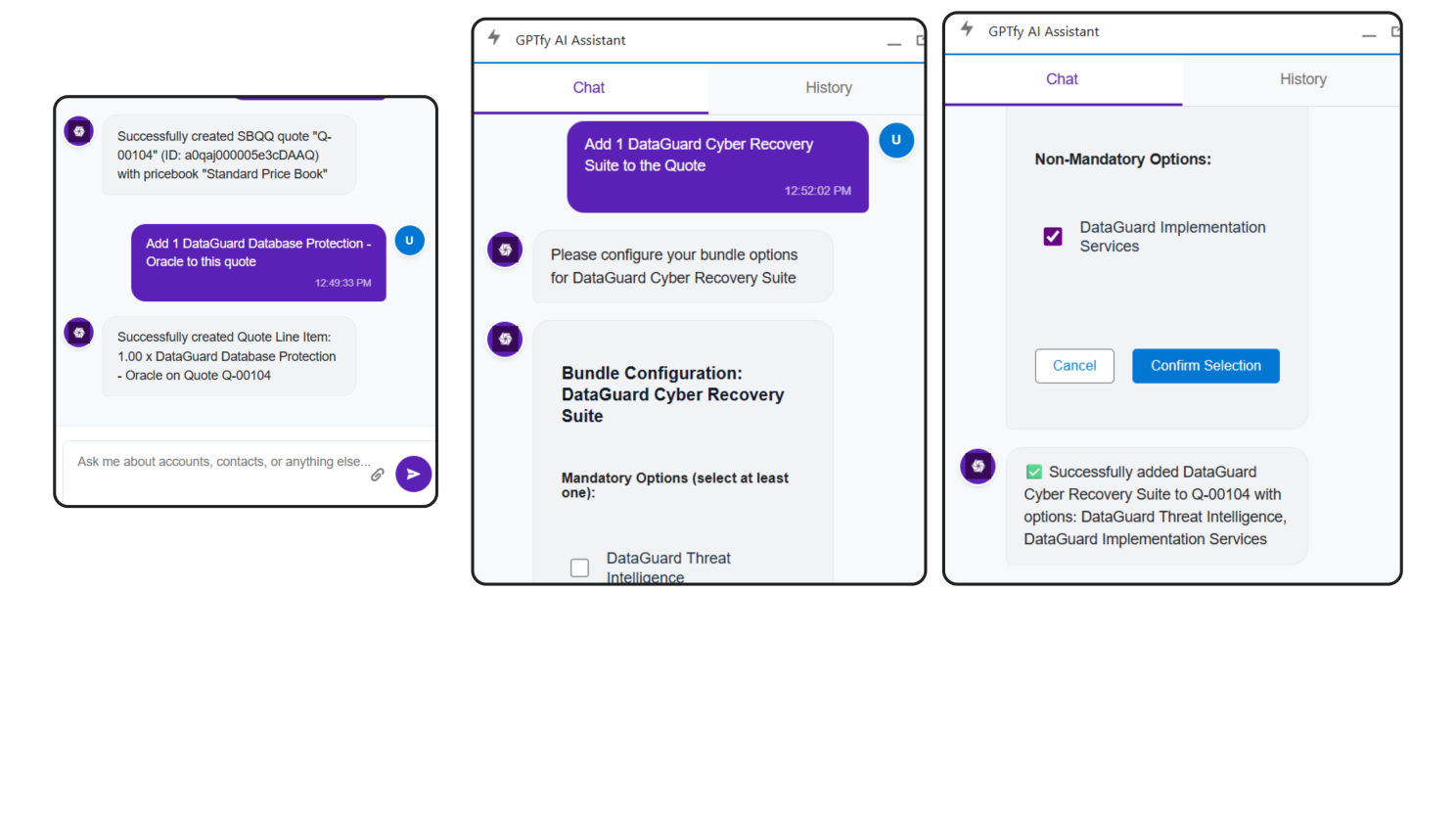
Consider a bundle called "Dataguard Cyber Recovery Suite." This product includes mandatory options (the user must select at least one) and optional add-ons. In traditional CPQ, configuring this requires:
- Adding the bundle to the quote
- Clicking through to the configuration
- Understanding which options are mandatory vs. optional
- Selecting appropriate choices based on customer needs
- Validating dependencies between options
- Completing configuration and returning to the quote
With conversational AI, when the user requests adding this bundle, the AI:
- Recognizes it as a complex product requiring configuration
- Retrieves the bundle structure from CPQ metadata
- Identifies mandatory vs. optional selections
- Presents choices conversationally
- Validates selections against CPQ rules
- Completes configuration automatically
The key insight: the AI doesn't bypass CPQ's business logic. It interrogates the existing configuration and presents it through a more intuitive interface.
Architecture That Respects Your Infrastructure
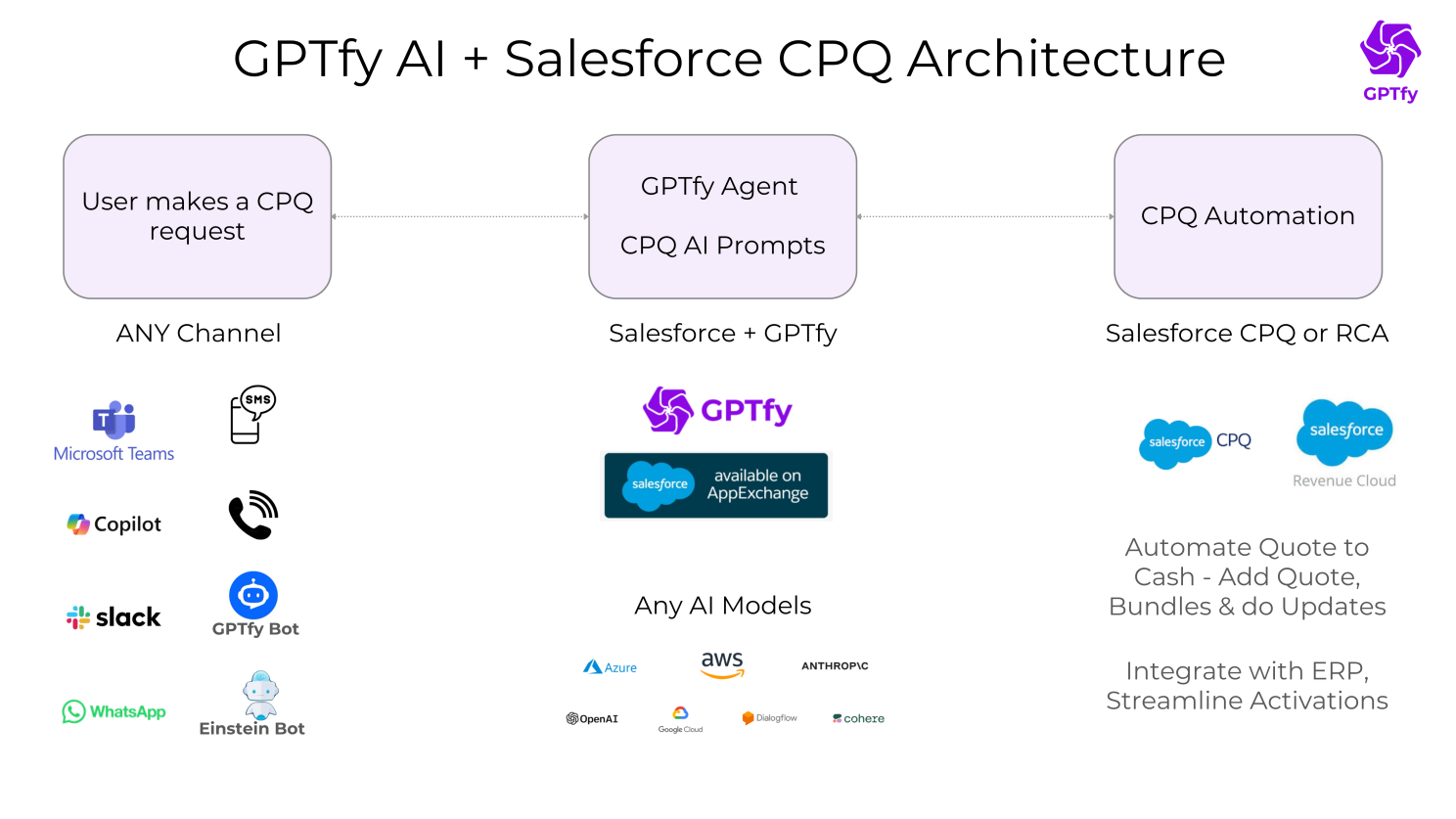
The implementation follows a straightforward pattern:
1. User Interface Layer
Natural language input through chatbot, voice, Slack, Teams, or WhatsApp. The interface captures intent but doesn't process the CPQ logic.
2. Agentic AI layer
Determines which CPQ operations the user wants to perform. This uses agentic AI capabilities to map conversational requests to specific functions.
3. GPTfy Agentic Layer
Translates AI understanding into concrete CPQ API calls. This layer handles data extraction, security masking, and business rule validation.
4. Salesforce CPQ
Processes all operations using standard APIs. Configuration rules, pricing logic, approval workflows - everything stays intact.
5. Your AI Model
Running on your infrastructure (Azure OpenAI, Google Vertex AI, AWS Bedrock, or others). You control the model, the data, and the costs.
Security Note: This matters because security-conscious organizations need to understand data flow. Customer data gets masked before reaching the AI model. The AI never sees actual customer names, emails, or sensitive information - only tokenized versions. Responses flow back through the same masking layer for reinjection of real data.
Beyond Text: Voice-Activated Quote Management
The system extends beyond chat to include voice capabilities. Users can call a phone number and speak naturally to access Salesforce data, create quotes, and manage opportunities - all through voice commands.
This demonstrates the broader principle: once AI can interact with CPQ data programmatically, the interface becomes flexible. Voice, chat, messaging apps - the data access remains consistent while the interaction method varies based on user preference or context.The Practical Configuration Reality
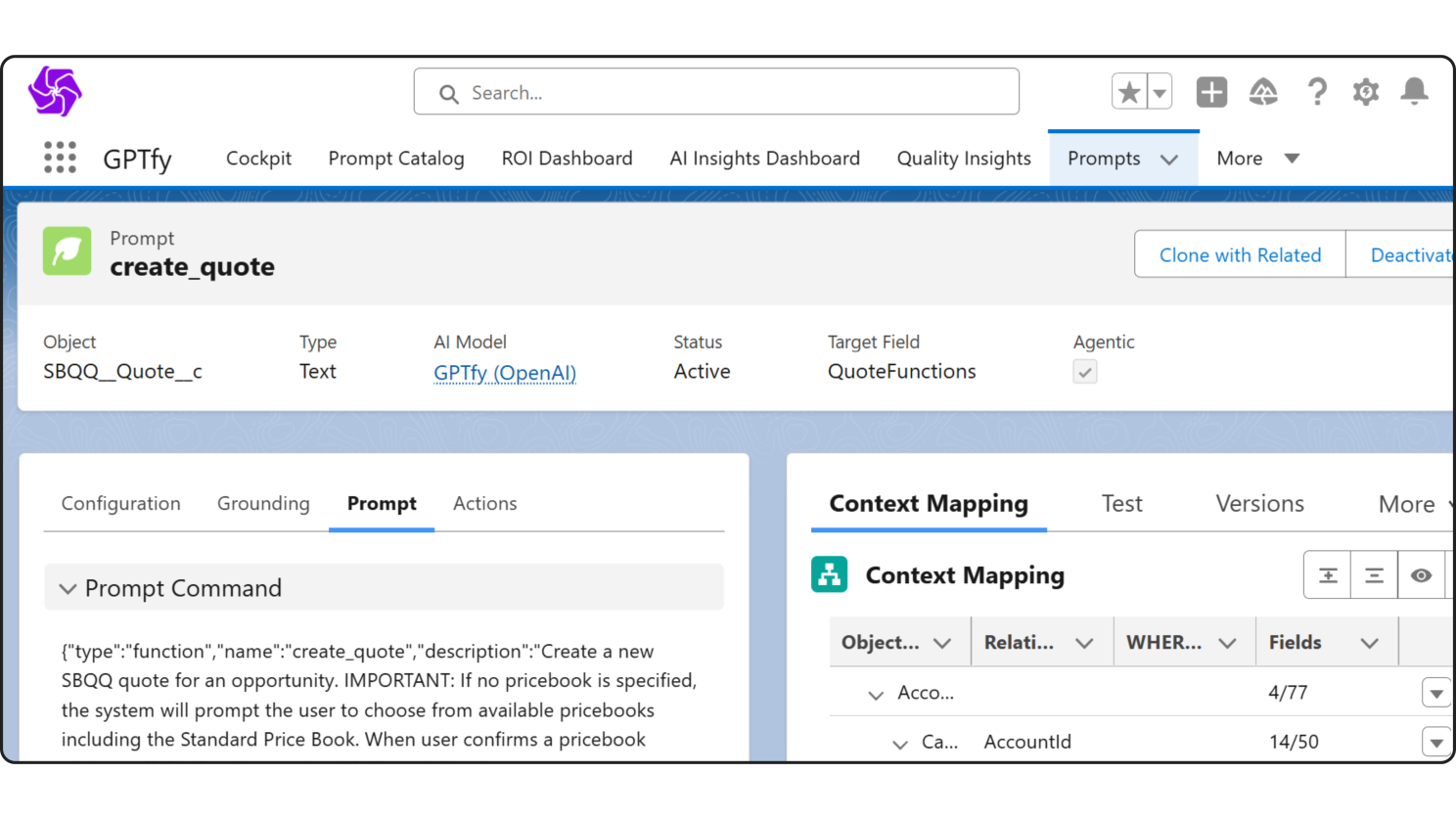
Setting up these capabilities requires understanding how prompts connect to CPQ actions. The GPTfy Prompt Builder interface clearly demonstrates this.
Agentic prompts define available functions. Each prompt contains:
- Plain English description of what the function does
- Required parameters (quote ID, product name, quantity, etc.)
- Business rule validation steps
- CPQ API endpoints to call
- Error handling logic
When a user types "add three AWS instances to this quote," the AI:
- Parses the intent (add product)
- Identifies the product (AWS instances)
- Extracts quantity (three)
- Validates the product exists in the price book
- Calls the appropriate CPQ API
- Confirms the action
The prompt configuration uses natural language, making it accessible to business analysts who understand CPQ requirements but may not write code.
Example: When attempting to add a misspelled product name, the AI responds:
"I cannot find that product."This shows the system validates inputs against actual CPQ data rather than blindly processing requests.
Implementation Timeline Reality Check
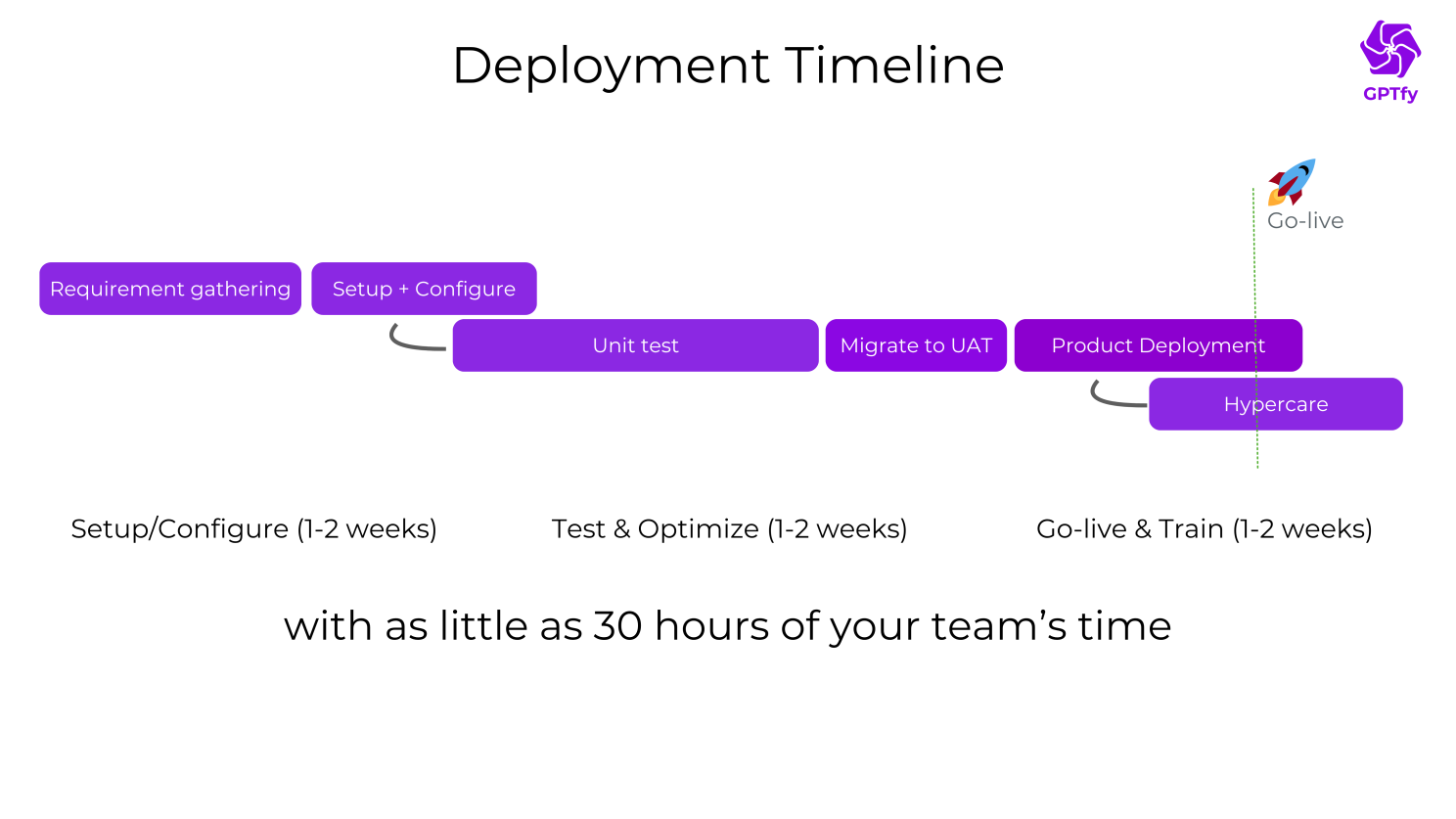
Organizations want to know: how long does this take?
The realistic answer: three to six weeks for production deployment.
This breaks down into:
Week 1-2: Foundation Setup
- Configure AI model connection
- Set up security layers
- Test basic connectivity
- Define initial use cases
Week 2-3: Prompt Engineering
- Build quote creation prompts
- Configure product addition logic
- Set up bundle configuration
- Test against actual CPQ data
Week 3-4: Business Rule Integration
- Map CPQ validation rules
- Configure approval workflows
- Set up error handling
- Test edge cases
Week 4-6: User Testing and Refinement
- Pilot with select users
- Gather feedback
- Refine prompts based on real usage
- Scale to broader user base
Note: Complexity varies by organization. Large enterprises with heavily customized CPQ instances require more configuration time. Smaller implementations with standard CPQ can move faster.
The Expanding Use Case Set
While the demonstration focused on quote creation, the underlying capability extends further:
RFP Response Automation
When sales teams work through RFPs or customer questionnaires before quoting, AI can analyze those documents against your knowledge base and suggest appropriate product configurations. Learn more about RFPs with AI in Salesforce here.
Upgrade and Renewal Workflows
For technology companies offering upgrade credits or early renewal incentives, the AI can apply business rules sitting outside CPQ. Instead of building complex logic into CPQ configuration, you teach the AI model about these policies. It synthesizes installed base data with upgrade rules to generate appropriate quotes.
Territory Realignment Support
When sales territories change, new reps need to understand existing customer configurations quickly. AI can provide conversational access to historical quote data and configuration patterns.
Deal Desk Automation
Routine modifications that currently require specialized team intervention can flow through AI-assisted workflows, freeing deal desk resources for genuinely complex scenarios.
What About Salesforce + AI Security?
Organizations rightfully obsess over security when considering AI integration with business-critical systems like CPQ.
A common question arises around voice-based access: "How do you ensure security in that scenario?"
For production implementations, several options exist:
Reverse Authentication
Identify the caller by phone number and authenticate against a list of known users before granting data access.
One-Time Password
Text a verification code to the registered number before enabling the conversation.
SSO Integration
For web-based interfaces (chatbot, Teams, Slack), standard single sign-on handles authentication. The user authenticates to their collaboration tool, which then authenticates to Salesforce using established protocols.
Architecture Note: GPTfy runs as a native Salesforce application. It doesn't maintain separate user databases or create additional authentication layers. It leverages Salesforce's existing security model - permission sets, profiles, sharing rules, and field-level security. Read more about GPTfy Architecture here
Data Masking
Data masking happens before information reaches the AI model. Customer names become tokens. Email addresses get replaced with identifiers. The AI processes anonymized versions and never stores the original data.
Audit Trail
Every interaction creates an audit record showing what data was accessed, which security tokens were applied, what was sent to the AI, and what came back. This audit trail satisfies compliance requirements in regulated industries.
Frequently Asked Questions
General Implementation Questions
Q: Could you create three quotes in one prompt? Yes. The system can handle multiple operations within a single conversational request. The AI parses the intent and executes multiple CPQ actions sequentially while maintaining business rule validation for each.
Q: Can you specify quantities and discounts through conversation?
Yes. Users can specify quantities, discounts, and other quote parameters conversationally. For example: "Add 15 AWS instances to this quote with a 10% discount." The system applies these parameters while respecting your CPQ business rules around discount approval limits.
Pricing and Business Model Questions
Q: How many tokens are included with pricing?
GPTfy uses a per-user subscription model ($30/user/month with 100-user minimum) rather than consumption-based pricing. Token costs go directly to your AI provider (Azure, GCP, AWS) based on your corporate agreements. This approach:
- Provides predictable budgeting
- Lets you leverage existing hyperscaler discounts
- Eliminates consumption surprise costs
- Gives you flexibility to choose models based on your needs
GPTfy includes usage tracking and analytics to help monitor costs and optimize your implementation.
Q: Why use an Overlay Solution like GPTfy versus Agentforce?
The choice depends on your architecture and needs:
GPTfy takes an overlay approach with:
- Lower activation energy to get started
- No dependency on Data Cloud
- Bring Your Own Model (BYOM) flexibility
- Fixed pricing model
- Works with your existing AI infrastructure investments
Agentforce provides embedded AI with:
- Deep integration with Salesforce Data Cloud
- Tightly coupled AI experiences
Overlay solutions like GPTfy let you get started quickly with AI and develop practice without major infrastructure changes. You maintain flexibility to use different AI models and leverage existing cloud investments. Check out more here
Feature and Capability Questions
Q: Can we have visual actions that users can interact with in the chat, especially for complex bundle dependencies? Yes. When bundles have dependencies or multiple configuration options, the AI can present these through interactive elements within the chat interface. Users can select options through buttons rather than typing everything.
The system reads CPQ's configuration metadata to understand which options are mandatory versus optional and presents them appropriately. This is still evolving - we're exploring more guided visual experiences for complex configuration scenarios. The framework is designed to be flexible in how it renders user experiences, from pure conversational to more visual/guided interfaces.
Q: Are there guardrail constraints with invoking our current CPQ setup and business rules? No constraints - the system is designed to honor all existing CPQ guardrails:
- Product rules and price rules stay in place
- Configuration controls are respected
- Approval workflows remain active
- All CPQ business logic is maintained
The AI doesn't bypass CPQ's architecture. It interrogates existing rules and presents them through a conversational interface. All the same validation, approval, and audit capabilities in CPQ continue to function. This is a key security and governance feature - we're not circumventing your carefully designed business rules.
Summary
Salesforce CPQ delivers powerful configuration capabilities but creates user experience friction through its multi-step interfaces. Conversational AI changes this interaction model by letting users describe what they need rather than clicking through structured workflows.
The approach shown combines natural language understanding with strict respect for CPQ's business rules, security requirements, and approval workflows. It doesn't bypass CPQ - it makes it more accessible.
Implementation takes three to six weeks, depending on CPQ complexity. The architecture uses an overlay model, requiring no Data Cloud dependency and supporting any AI infrastructure you choose. Security happens through native Salesforce mechanisms plus data masking before information reaches AI models.
The broader implication: once CPQ data becomes conversationally accessible, the interface options multiply. Voice, chat, messaging apps, and collaboration tools all become viable quoting interfaces while maintaining the guardrails that CPQ provides.
